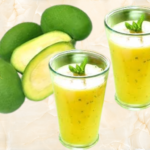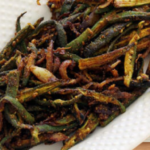Mango Pickle Recipe | Aam Ka Achar
Mango Pickle Recipe | Aam Ka Achar, Welcome to the world of mango pickle, where tangy, spicy flavors come together in a delightful medley. If you’ve ever wondered how to make this quintessential Indian condiment, you’re in the right place. Mango pickle, or “aam ka achar,” is a staple in many households, beloved for its vibrant taste and ability to elevate any meal. I will share, how to make your very own mango pickle.

Ingredients Needed for Mango Pickle Recipe
Main Ingredients
- Raw mangoes: 1 kg (about 4-5 medium-sized mangoes)
- Salt: 100 grams (approximately 1/2 cup)
Spices and Seasonings
- Fenugreek seeds: 2 tablespoons
- Mustard seeds: 2 tablespoons
- Fennel seeds: 1 tablespoon
- Nigella seeds (kalonji): 1 tablespoon
- Turmeric powder: 1 tablespoon
- Red chili powder: 3 tablespoons
- Asafoetida (hing): 1/2 teaspoon
- Mustard oil: 250 ml (1 cup)
Choosing the Right Mangoes
Types of Mangoes
When making mango pickle, selecting the right type of mango is crucial. Opt for raw, firm, and slightly sour mangoes. Varieties like Rajapuri or Totapuri are excellent choices due to their tangy flavor and firm texture.
Tips for Selecting Mangoes
Look for mangoes that are green with a smooth skin. They should be firm to the touch without any soft spots or blemishes. Avoid overripe mangoes as they can become mushy during the pickling process.
How to Make Mango Pickle

Preparation Steps of Mango Pickle recipe
Washing and Drying Mangoes
Thoroughly wash the mangoes to remove any dirt or pesticides. Pat them dry with a clean cloth and leave them to air dry completely. Any moisture can spoil the pickle, so make sure the mangoes are entirely dry before proceeding.
Cutting the Mangoes
Cut the mangoes into bite-sized pieces, approximately 1-2 cm chunks. There’s no need to peel the mangoes, but remove the seeds. It will be safer and easier to complete this task using a sharp knife (carefully).
Spice Preparation
Roasting the Spices
To enhance the flavors, dry roast the fenugreek, mustard, and fennel seeds in a pan over medium heat until they become fragrant. This should take about 2-3 minutes. Be careful not to burn them.
Grinding the Spices
Once the spices are roasted, allow them to cool slightly. Use a spice grinder or mortar and pestle to coarsely grind them. The coarse texture adds a lovely crunch to the mango pickle recipe.
Mixing the Ingredients
Combining Mangoes with Spices
In a large mixing bowl, combine the mango pieces with the ground spices, nigella seeds, turmeric powder, red chili powder, asafoetida, and salt. Mix well to ensure the mango pieces are evenly coated with the spices.
Adding Oil and Other Ingredients
In a pan, heat the mustard oil until it starts to smoke. Allow it to cool slightly before pouring it over the mango and spice mixture. The hot oil helps in preserving the pickle and enhances its flavor. Mix everything thoroughly.
Storage Instructions
Selecting the Right Container
Use a sterilized glass jar or ceramic container to store the pickle. Avoid using plastic containers as they can react with the acidic content of the pickle.
How to Store the Pickle
Transfer the mango pickle into the container, pressing down firmly to remove any air pockets. Ensure there is a layer of oil covering the top to prevent spoilage. Seal the container tightly.

Fermentation Process
Ideal Fermentation Conditions
Place the container in a warm, dry place away from direct sunlight. The ideal temperature for fermentation is around 25-30°C (77-86°F).
How Long to Ferment
Allow the pickle to ferment for at least two weeks. The tastes will develop and blend throughout this period of time. Stir the pickle every few days using a clean, dry spoon.
Serving Suggestions
Best Dishes to Pair with Mango Pickle
Mango pickle is incredibly versatile and pairs well with a variety of dishes. Serve it with rice, dal, parathas, or even sandwiches for an extra kick of flavor.
How to Serve Mango Pickle
A small spoonful is usually enough to enhance the taste of your meal. Be mindful of its strong, bold flavors and use sparingly.
Health Benefits of Mango Pickle
Nutritional Value
Mango pickle is rich in vitamins A, C, and K from the mangoes, as well as essential minerals like iron and calcium from the spices.
Probiotic Benefits
The fermentation process introduces beneficial bacteria, making mango pickle a good source of probiotics that aid in digestion.
Common Mistakes to Avoid of Mango Pickle recipe
Over-Spicing
It’s easy to get carried away with the spices, but balance is key. Over-spicing can overwhelm the pickle’s natural flavors.
Incorrect Fermentation
Ensure the container is airtight and stored in the right conditions. Improper fermentation can lead to spoilage or an unpleasant taste.
Tips for Perfect Mango Pickle recipe
Balancing Flavors
Taste your pickle mixture before fermenting. Adjust the salt and chili powder as needed to suit your palate.
Ensuring Longevity
Always use clean, dry utensils when handling the pickle to prevent contamination and extend its shelf life.
Variations of Mango Pickle recipe
Regional Variations
Different regions have their unique takes on mango pickle. For example, South Indian mango pickle often includes curry leaves and a distinct blend of spices.
Creative Twists
Experiment with adding garlic, ginger, or even jaggery for a sweet and spicy version of mango pickle.
Fixing Issues with Your Mango Pickle recipe
Dealing with Mold
If you notice mold, remove the affected part immediately. Ensure the remaining pickle is covered with a layer of oil and stored properly.
Fixing Overly Sour Pickle
If your pickle is too sour, try adding a bit of sugar or jaggery to balance the flavors.

FAQs (frequently Asked Questions)
How long does mango pickle last?
Mango pickle can last up to a year if stored properly in a cool, dry place. Ensure the pickle is always covered with a layer of oil to preserve it.
Can I use ripe mangoes?
It’s best to use raw, firm mangoes for pickling. Ripe mangoes can become too soft and spoil quickly.
What kind of oil is best for mango pickle?
Mustard oil is traditionally used due to its strong flavor and preservative qualities. However, you can also use other oils like sesame or peanut oil.
How do I know if my mango pickle has gone bad?
Signs of spoilage include an off smell, mold growth, or a change in color. If you notice any of these, it’s best to discard the pickle.
Can I adjust the spice level?
Absolutely! Feel free to adjust the amount of red chili powder and other spices to suit your taste preferences.
Conclusion
Making mango pickle at home is a rewarding experience that connects you with a rich culinary tradition. With the right ingredients, a bit of patience, and this step-by-step guide, you’ll have a delicious mango pickle ready to enhance your meals. Try different things and personalize the recipe without fear. Happy pickling!


